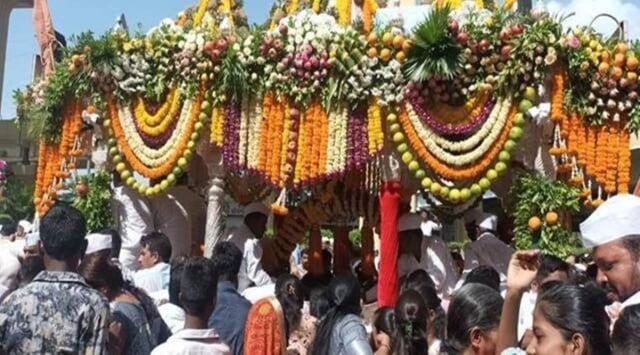A delayed monsoon has kept the farming community in Maharashtra busy with sowing various crops and contributed to a lower-than-usual attendance for the annual Palkhi processions of Sant Tukaram Maharaj and Sant Dnyaneshwar Maharaj that arrived in Pune Monday afternoon.
Vikas Dhage Patil, a trustee of the Sant Dnyaneshwar Maharaj temple committee of Alandi, said the attendance was estimated to be lower by around 20-25 per cent. “Every year, the Palkhi of Sant Dnyaneshwar Maharaj is accompanied by around 5 lakh people. This year the number is around 3-3.5 lakh,” he said, adding that this was mainly because of the delayed monsoon.

Abhijeet More, a trustee of the Sant Tukaram Maharaj temple committee, talked about a 20 per cent dip in attendance in their contingent.
Story continues below this ad
The Palkhi or the processions of the palanquins carrying the Paduka or revered symbolic footwear of Sant Tukaram Maharaj and Sant Dnyaneshwar Maharaj started the three-week-long journeys on Saturday and Sunday, respectively, from the temple towns of Dehu and Alandi and are slated to reach Pandharpur in the Solapur district on June 29.
The pilgrimage draws lakhs of devotees from across the state. Agriculture is the mainstay of most of them, and they usually finish their sowing before joining the procession. With many waiting for the first heavy showers to commence their sowing, the attendance has been hit this time.
The monsoon typically arrives in Maharashtra by June 7, with most rain-fed areas reporting moderate to heavy rainfall by then. Given that most of the state is rainfed, any delay in monsoon impacts the attendance of warkaris (devotees) for the processions.
This year, the monsoon entered Konkan and parts of south Maharashtra only on June 11, and most of the state is yet to see any substantial rainfall. The India Meteorological Department (IMD) has predicted a dry June for Maharashtra and advised farmers to commence sowing only after 100 mm of rainfall is recorded.
Story continues below this ad
The June-July sowing period is essential for crops like urad, moong, cotton, soyabean etc. Of these, urad and moong can only be sown up until June, with their area taken up by other crops beyond that. Most farmers have readied their farms for planting either cotton or soyabean and are waiting for good spells of rain.
Those farmers who made the trip talked about how they had kept everything ready for the sowing to begin once the state witnesses a heavy spell of rain.
Vitthal Maharaj Dengale’s group of pilgrims from the Sengaon taluka in the Hingoli district is thinner by over 100 people. Dengale, who has been part of the annual Alandi to Pandharpur pilgrimage for the last 20 years, attributed this to the absence of rain. “Farmers are yet to start sowing. Those who have people to take care of sowing joined the group; others stayed back,” he said.
Ramesh Kendre, from the Bodhadi village in Nanded, has completed the preparation of sowing soyabean over 6 acres of his holding. “Normally, my sons and other relatives accompany me, but I have come alone this year as sowing is yet to commence. Bags of soyabean are ready; we just need the rain,” said Kendre, part of the around 300 people accompanying the Sant Savata Mali Dindi.
Story continues below this ad
Vaibhav Agarwal from the village of Anamal in Nanded also expressed the same sentiments. “Ironically, it rained in summer, and when we require rain to commence sowing, it is missing,” he said.
Laxman Wabale from the Agashti Ashram in Akole taluka of Ahmednagar talked about his 8 acres yet to see sowing. “Many of my neighbours could not join because of this,” he said.









